
Design Consultancy vs Client — What can we do?
(Long reads)
2015
“Trust is a core issue
at the beginning of
a business relationship.” (Lewicki and Bunker, 1995)
The client’s trust is the main goal for design consultancies in establishing their business relationships. This process of trust building can be time-consuming, especially for start-up design consultancies. At this point, the factors that influece theprocess, which are: Ability, Benevolence and Integrity, would work collaboratively and might consist of various elements (Mayer et al., 1995). Accelerating this process requires strategies for consultancies in terms of project management and communication skills. The combination of the elements should benefit the bothparties not only from business perspective, but also take them to a lasting client relationship.
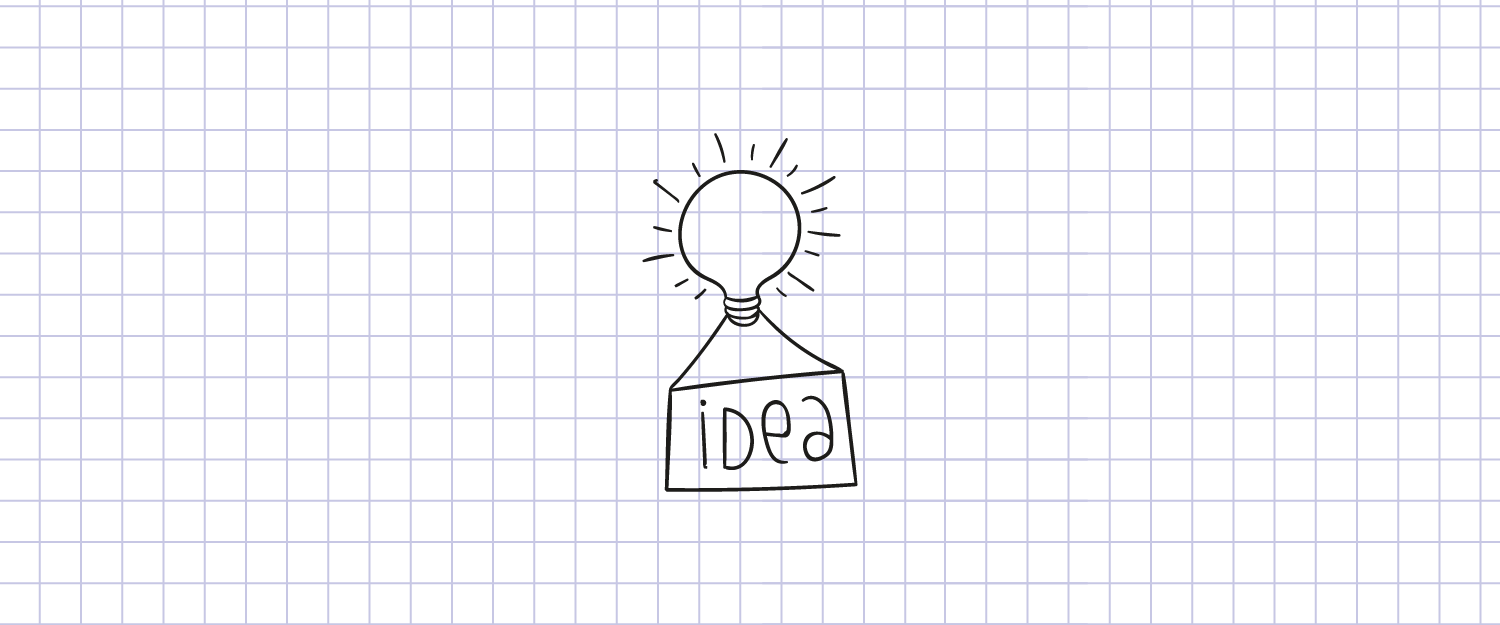
Where are we?
Graphic designers have always dreamt of running their own design consultancy frequently. Running a start-up design consultancy might require more information on internal business issues in running a new a business, where they would prepare and build every component from the scratch. Fishbein (2014) suggests that a young business consultancy should enhance the creativity in specialising the business differently from the competitors.
The issue of start-up business has recently grown in importance. Perkins (2010) discusses thatmany new design consultancies have to close down their business practices, not because of theirperformance in delivering qualified design outcome. They might meet challenges regularly toestablish their client relationship. The several obstacles are possibly faced might be competition amongst the other consultancies, a lack of in-depth market research, poor design planning, delivering a good design and client engagement.
Delivering a successful design should be every consultancy’s goals, where it should be aligned with punctuality, be on budget and bring profit (Perkins, 2010). At this point, a design consultancy should consider their project and time management in order to satisfy the client. Undoubtedly, negotiation issues would occur regularly during the design development process. This would require the consultancy to have a good capability in project management and communication.
In order to understand how a project management and communication work collaboratively in establishing a client relationship, I appoint this as a topic of this research.The capability to understand and examine a trust building process between a design consultancy and its clients must be required, and to develop the process that would be applied and evaluated for design consultancies.
The issue of start-up business has recently grown in importance. Perkins (2010) discusses thatmany new design consultancies have to close down their business practices, not because of theirperformance in delivering qualified design outcome. They might meet challenges regularly toestablish their client relationship. The several obstacles are possibly faced might be competition amongst the other consultancies, a lack of in-depth market research, poor design planning, delivering a good design and client engagement.
Delivering a successful design should be every consultancy’s goals, where it should be aligned with punctuality, be on budget and bring profit (Perkins, 2010). At this point, a design consultancy should consider their project and time management in order to satisfy the client. Undoubtedly, negotiation issues would occur regularly during the design development process. This would require the consultancy to have a good capability in project management and communication.
In order to understand how a project management and communication work collaboratively in establishing a client relationship, I appoint this as a topic of this research.The capability to understand and examine a trust building process between a design consultancy and its clients must be required, and to develop the process that would be applied and evaluated for design consultancies.
So what?
This research should address broad issues for a young consultancy. I will persist to explore the issues, where I could apply in my own future design consultancy. As previously mentioned in the last section, this research might be suitable not only for a start-up consultancy. Trust building process should be involved in a client relationship from the beginning and build the level of trust higher as the relationship grows.

Then how do I solve the question?
A qualitative research is applied, where case study and samplings method are applied to support the data collection. The purpose of this study was to explore the connection amongst factors of trustworthiness in design consultancy and client’s relationship. At this stage of this research, methods of inquiry included a case study and observation through four samplings from start-up design consultancy. The case study identifies the findings and consolidates from various literatures, and the study of samplings aimed to verify the hypothesis.
1. Phase 1: Case Study
The ten years relationship between Design School (as Design Consultancy) and Company-A (as client).
2. Phase 2: Sampling
Four selected design consultancies in EU are examined for supporting the case study. The consultancies are known as Consultancy-A; Consultancy-B; Consultancy-C and Consultancy-D.
From this research, not only Design School, as a design consultancy in the case study, but also every consultancy in samplings emphasise that communication has a big role in their relationship with the clients. To begin with a clear understanding the clients’ need should benefit the relationship to going further.
At this end,the combination of well-organised project management and good communication skills should increase the level of trust, which could lead in accelerating the level of relationship, in which turns to a trust model. In other words, every design consultancy should have its own way to treat every client or project.
1. Phase 1: Case Study
The ten years relationship between Design School (as Design Consultancy) and Company-A (as client).
2. Phase 2: Sampling
Four selected design consultancies in EU are examined for supporting the case study. The consultancies are known as Consultancy-A; Consultancy-B; Consultancy-C and Consultancy-D.
From this research, not only Design School, as a design consultancy in the case study, but also every consultancy in samplings emphasise that communication has a big role in their relationship with the clients. To begin with a clear understanding the clients’ need should benefit the relationship to going further.
At this end,the combination of well-organised project management and good communication skills should increase the level of trust, which could lead in accelerating the level of relationship, in which turns to a trust model. In other words, every design consultancy should have its own way to treat every client or project.
Discussion time!
A Preliminary Model
The case study of Design School and Company-A is observed based on their relationship process that includes their trust-building process, design project management and the communicationaspect. From this point, a balanced model that helped Design School to establish their relationship with Company-A, is constructed and at the same time to be validated and applied to the other design consultancies.
From the case study of Design School, I believe a combination of abilities, benevolence and integrity in trust-building process have a significant impact toward the time that they need to reach the partnership stage. These three factors are known as antecedents or attributes to cause increasing trust in a relationship process and be applied to the following model:
From the case study of Design School, I believe a combination of abilities, benevolence and integrity in trust-building process have a significant impact toward the time that they need to reach the partnership stage. These three factors are known as antecedents or attributes to cause increasing trust in a relationship process and be applied to the following model:
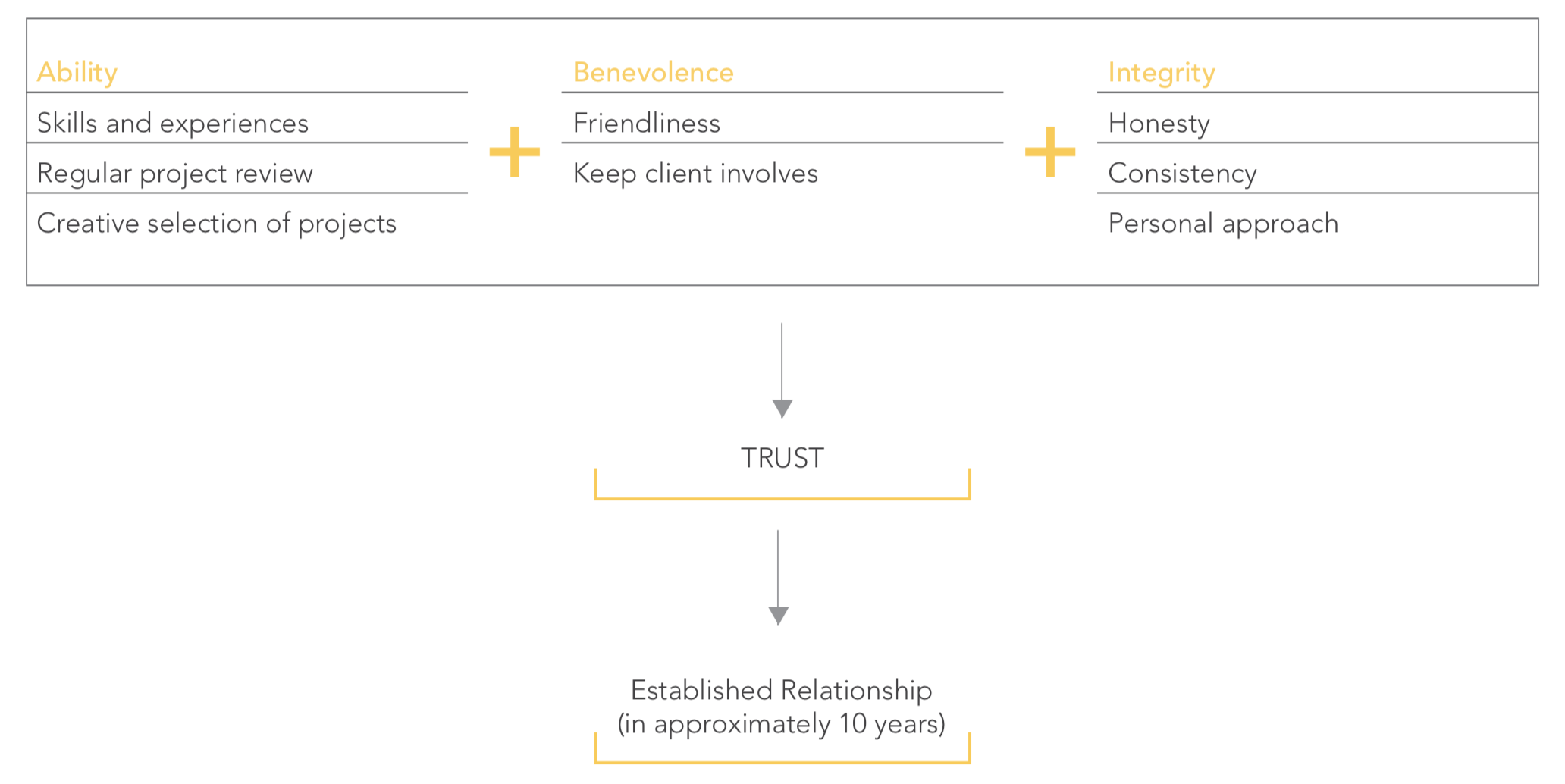
(The Case Study Trust Model)
Evidently, the samplings were going to be validated by the previous model. The following table illustrates the result of the model validation. The indicator (◊) represents the strength of evidence that has already been previously mentioned through the data analysis. At this point, the result helps me examine the model and predict the challenge that could delay the relationship development process. Moreover, it is apparent from the table that more factors that affect each relationship. The characteristic of additional factorsmight not benefit the design consultancy. It would be recognised by the comparison of eachperiod of existence and period of time to reach the last stage of relationship.
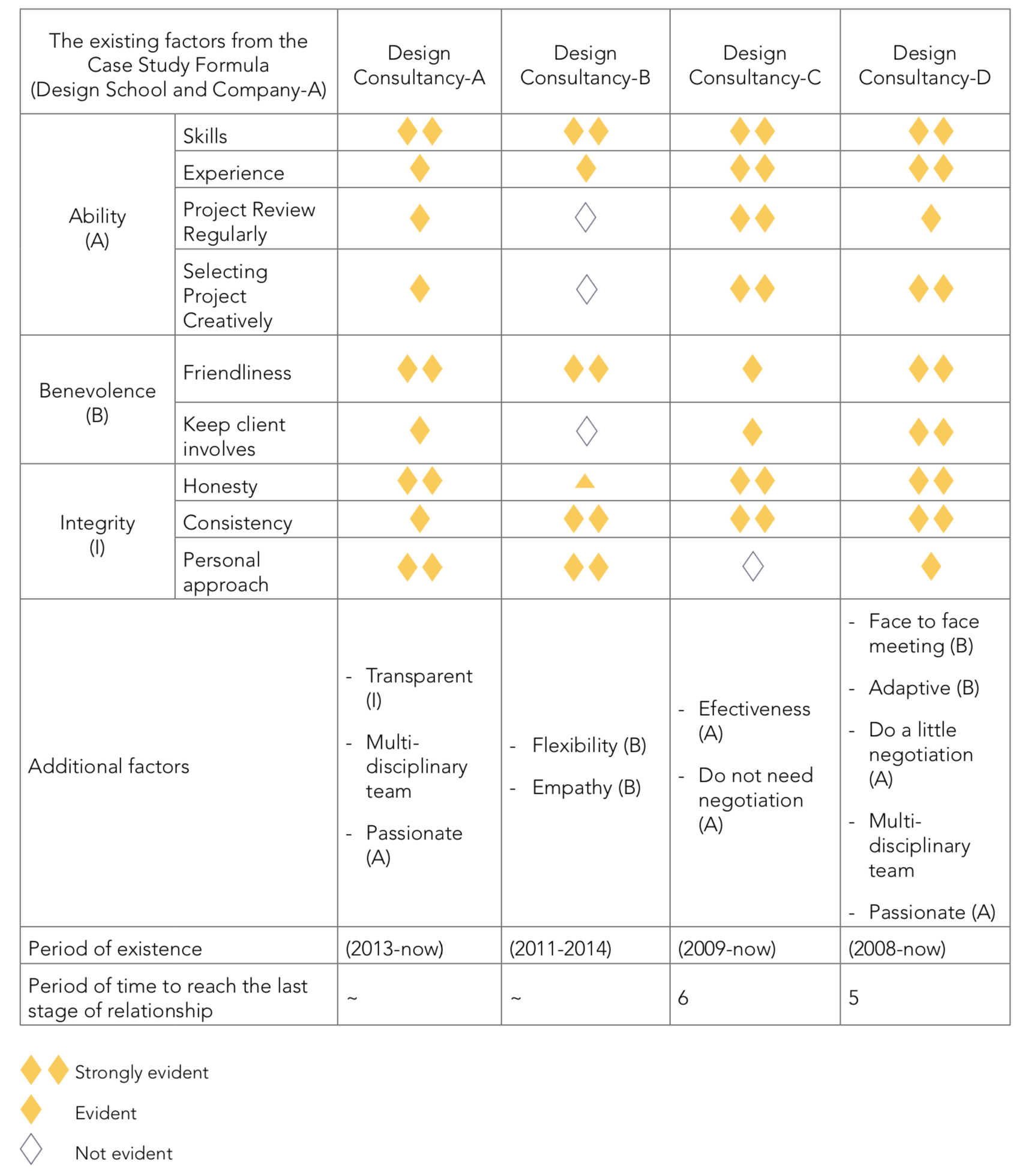
(Trust Model Validation)
The Result
Finally!
Based on this validation, every consultancy had a different duration to move from involvement stage to partnership stage. At this point, it may be the case that they might have a different approach in increasing their level of trust. Skills, being nice and friendly, and consistency are shown as the strong evident variables. In addition, other variables occurred and should be classified to the group of Ability, Benevolence and Integrity.
The discussions from the previous findings have implications for conducting a new model. The previous model might not perform its strength completely. Therefore, the new model would be constructed by the existing elements combines with the additional elements from the previousmodel validation. However, selecting the new elements is considered to improve the model inaccelerating the trust-building process. The additional elements are as follows:
With this new model, the combination of a preliminary model with the additional variables should improve the level of trust in a client relationship and to accelerate the need of time in increasing the level of trust. In this case, the time that a design consultancy needs to achieve an established relationship could be expectantly in less than 10 (ten) years. Those new variables or factors could be implemented to a new model below:
The discussions from the previous findings have implications for conducting a new model. The previous model might not perform its strength completely. Therefore, the new model would be constructed by the existing elements combines with the additional elements from the previousmodel validation. However, selecting the new elements is considered to improve the model inaccelerating the trust-building process. The additional elements are as follows:
- Passion
- Face-to-face meeting
- Efficient negotiation
- Effective design process
- Multidisciplinary teamwork
- Leadership
With this new model, the combination of a preliminary model with the additional variables should improve the level of trust in a client relationship and to accelerate the need of time in increasing the level of trust. In this case, the time that a design consultancy needs to achieve an established relationship could be expectantly in less than 10 (ten) years. Those new variables or factors could be implemented to a new model below:
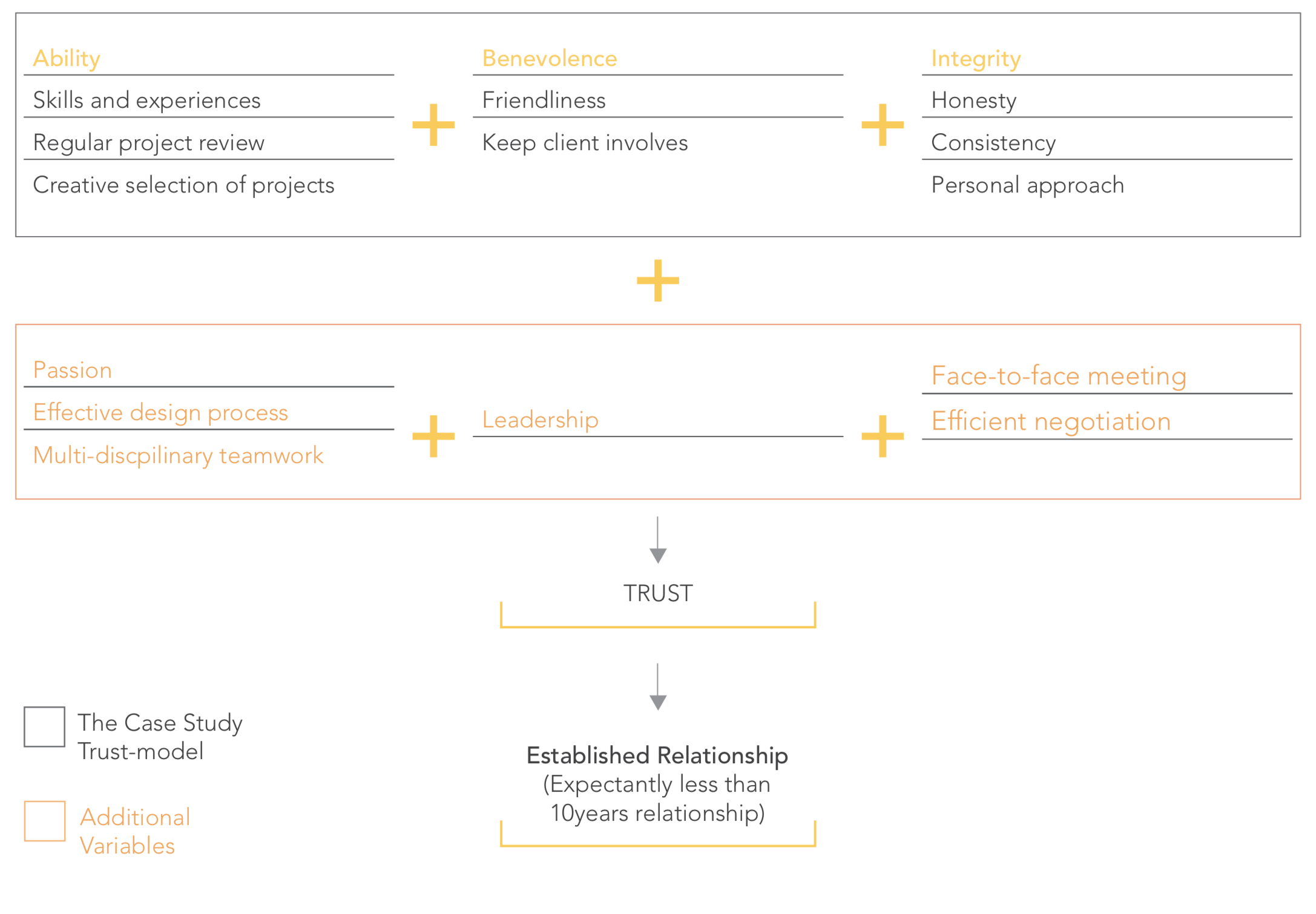
(The New Trust Model)
By applying these strategies in trust building process in a design consultancy, they should accelerate the process in establishing its client relationship that could be formed by collaboration to partnership project and the need of a good project management and communication skills are required.
![]()
(The Breadth of Trust vs Depth of Relationship)
To conclude, the movement from one stage to another stage in relationship might not be smooth and linear. It should be influenced by the level of trust that is already built during the relationship. At this point, the higher level of trust of the relationship should follow by less time required.
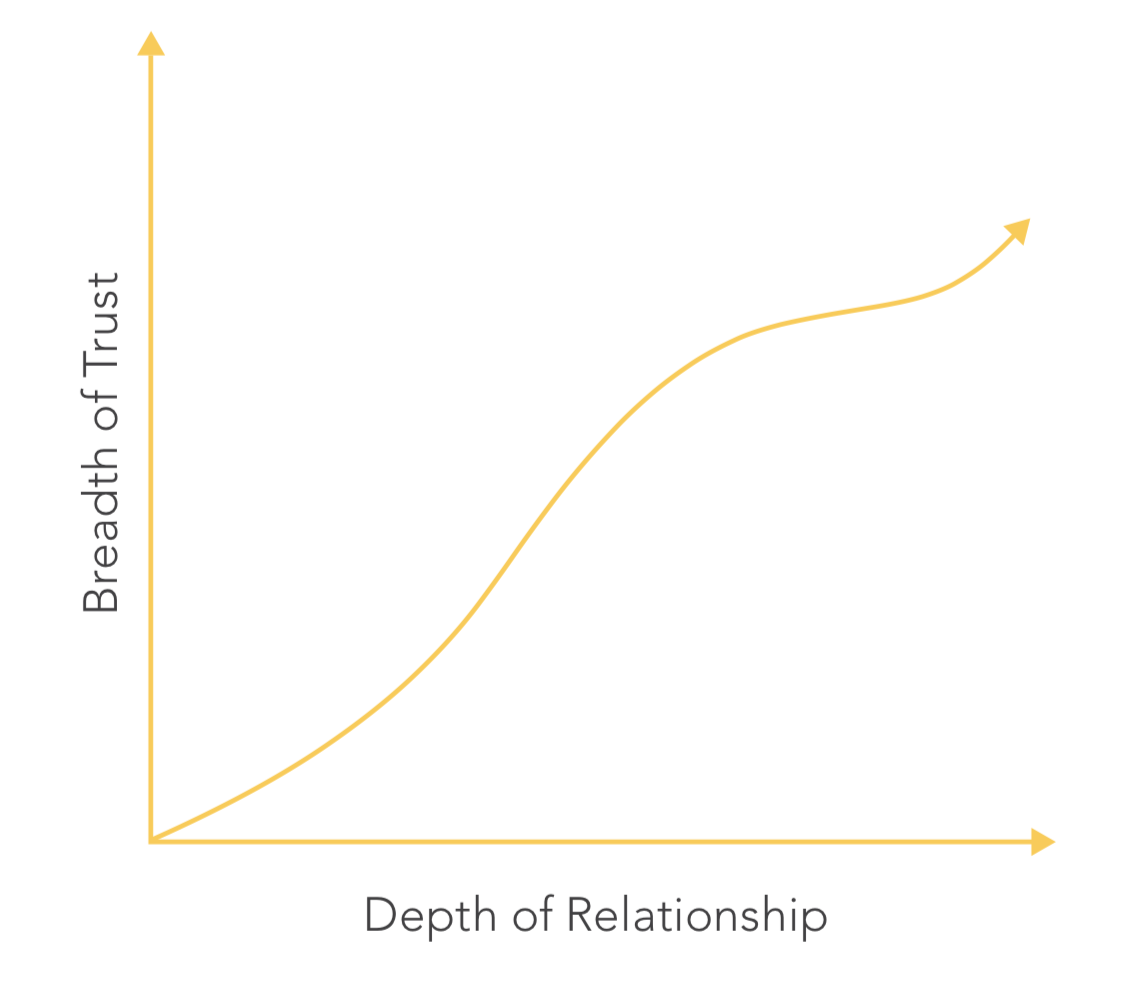
(The Breadth of Trust vs Depth of Relationship)
